Mode of Nutrition In Plants
- Books Name
- SOLUTIONistic HALT Science Book
- Publication
- SOLUTIONistic HALT
- Course
- CBSE Class 7
- Subject
- Science
Mode of Nutrition In Plants
- Books Name
- CBSE Class 7 Science Book
- Publication
- Param Publication
- Course
- CBSE Class 7
- Subject
- Science
Autotrophic Nutrition
![]()
When organisms make their food from simple inorganic substances like H2O and CO2, than it is called Autotrophic Nutrition. Such organisms are called Autotrophs.
All Green plants are Autotrophs or Producers because they make their own food by the process of photosynthesis.
(i) Photoautotrophs : Those which utilize sunlight for preparing their food. e.g. plants, algae, purple red and green bacteria.
(ii) Chemoautotrophs : Those which utilize chemical energy for preparing their food. e.g. Nitrifying bacteria, iron bacteria, sulphur bacteria, methane bacteria.
Mode of Nutrition In Plants
Chapter 1: Nutrition in Plants
Mode of Nutrition In Plants
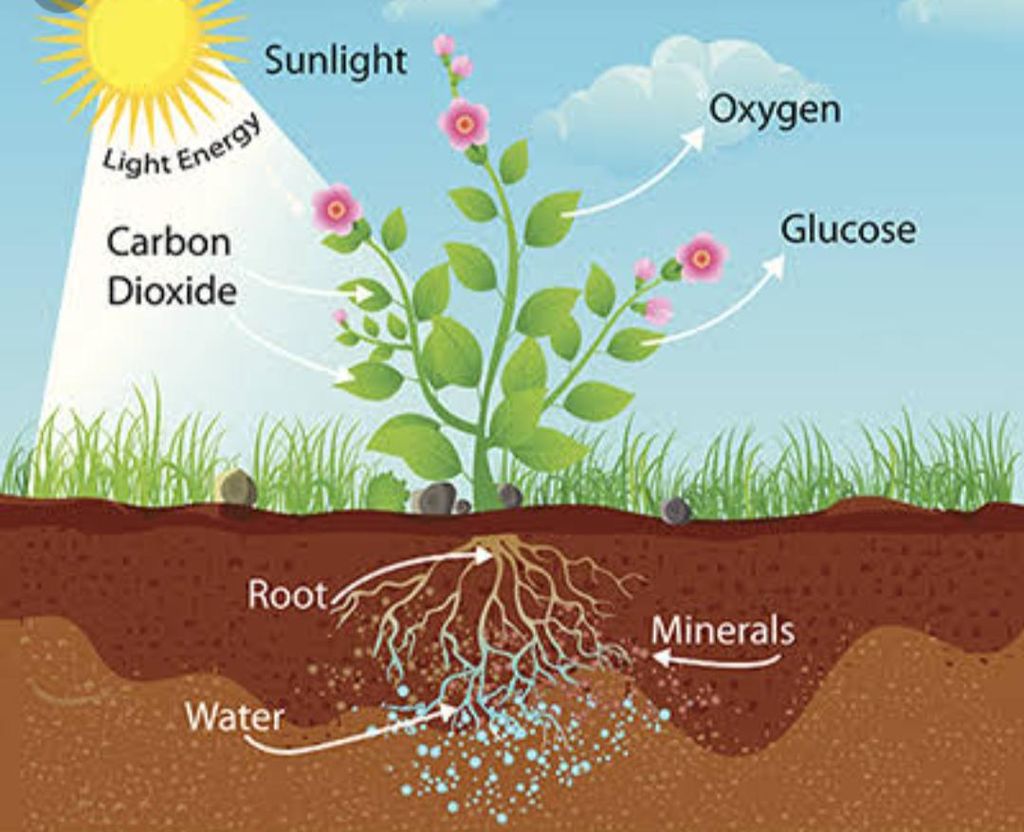
All the living organism plants and animals require food. The organism need to take food obtain energy and to obtain minerals for growth and to obtain mineral for the repair of damage part of the body .The process of taking food by an organism as well as the utilisation of this food by the organism is called nutrition. Plants can make their own food but animals cannot make the food themselves. They obtain food from plants or other animals that eat plants thus, the human beings and animals depend on plants for their food ,directly or indirectly .
Modes of Nutrition in plants
The method of obtaining food are called modes of Nutrition .On the basis of their modes of Nutrition all the organism can be divided into two main groups.( Autotrophs and Heterotrophs)
Autotrophs – Those organism which can make food themselves from simple substance like carbon dioxide and water by the process of photosynthesis are called autotrophs.
Heterotrophs- Those organism which cannot make food themselves by the process of photosynthesis and take food from green plants or animals are called heterotrophs.
Photosynthesis — Food Making Process in Plants
- Books Name
- CBSE Class 7 Science Book
- Publication
- Param Publication
- Course
- CBSE Class 7
- Subject
- Science
Photosynthesis
The process by which green plant prepare their food in the presence of sunlight, (Carbondioxide)CO2 , water, chlorophyll.
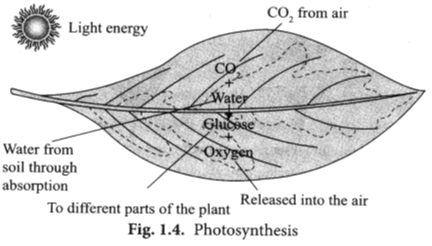
![]()
There are four requirement for photosynthesis.
(A) Sunlight:- It comes from sun & provide energy for photosynthesis.
(B) Carbon dioxide (CO2):- It is obtained from air and taken through tiny pores called stomata present on the under surface of leaves.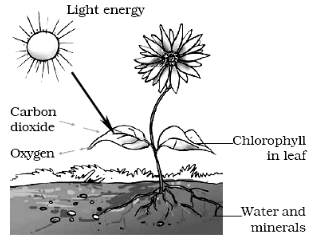
(C) Chlorophyll:- The chlorophyll is present in the chloroplast. Chloroplast regarded as Kitchen of cell and present in Green leaves.
• Besides chlorophyll cetain other pigments are also present in plants like :
(a) Carotenes : Organe in colour e.g. Carrot.
(b) Xanthophylls : Orange yellow in colour e.g. Maize.
(c) Phycobilins : Different colours like red, violet e.g., Blue-green algae, brown algae etc.
(D) Water (H2O):- They are obtained from the soil by the roots of plants and are transported to the leaves.
Plants have Vascular tissues called Xylem & Phloem.
(i) Xylem transport water and minerals to the leaves.
(ii) Phloem transport food (Sucrose) to various part of plant.
Photosynthesis — Food Making Process in Plants
Photosynthesis – food making process in plants
The plants use the energy in sunlight to prepare food in the presence of a green colour matter called “chlorophyll” present in the leaves of a green plant. The process by which green plants make their own food (like glucose) from carbon dioxide and water by using sunlight energy (in the presence of chlorophyll) is called photosynthesis.
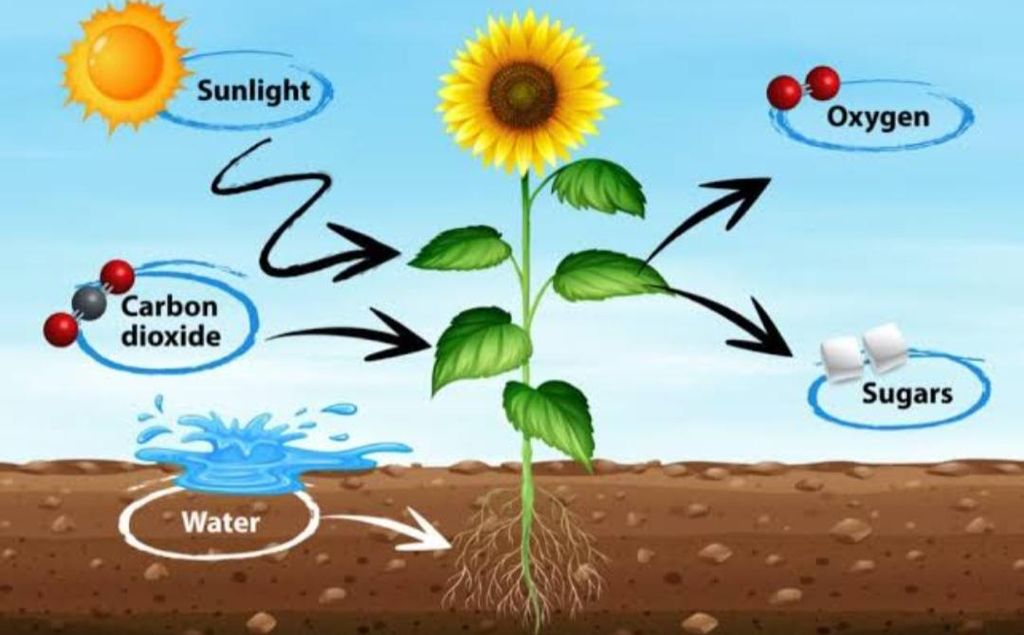
Carbon dioxide + Water → Glucose + Oxygen The process of photosynthesis takes place in the leaves of a plant. Oxygen gas is produced during photosynthesis which is utilised by all the living organisms for their survival. The process of photosynthesis first produces a simple carbohydrate called ‘glucose’ as food. The glucose carbohydrate then gets converted into a complex carbohydrate called Starch. Starch gets stored as food in the various parts of plant including leaves. Some of the glucose is also converted into other types of plant foods such as fats and oils, proteins as well as vitamins. The synthesis of food (or making of food) occurs in the leaves of a plant, so leaves are the food factories of a plant. The leaves of a plant can synthesise food because they contain a green pigments chlorophyll (which is necessary for making food). Other parts of a plant usually cannot synthesise food because they do not contain chlorophyll.
Other Modes of Nutrition in Plants
- Books Name
- CBSE Class 7 Science Book
- Publication
- Param Publication
- Course
- CBSE Class 7
- Subject
- Science
HETEROTROPHIC NUTRITION
![]()
1. The mode of Nutrition in which organisms obtain food from plants or other animals is called Heterotrophic Nutrition. These organisms are called Heterotrophs.
2. Some plants do not have chlorophyll so they cannot synthesize their food and depends on other plants or animals. Such non-green plants include fungi some bacteria and some flowering plants.
3. Heterotrophic plants can be divided in the following types.
(A) Parasitic Plants
(B) Saprophytic Plants
(C) Symbiotic Plants
(D) Insectivorous Plants
(A) Parasitic Plants
Some non-green plants obtain their food from other green plants are called parasitic plants. The plant which provides food is called host plant. The parasitic plant develop special roots for absorption of food. These roots called haustoria. Haustoria penetrate the host tissues and reaches the vascular bundles (xlyem & phloem).
• Parasitic Plants are of two types:-
(a) Total parasitic plant: Completely depend on host plant for their food.
e.g. (i) Cuscuta or Amarbel
(ii) Apodanthes
(iii) Rafflesia (Largest flower in the world)
(b) Partial parasitic plant:- These plant have green leaves and can synthesise their food but depend on host plant for water & minerals. e.g. Mistletoe, Sandalwood.
(B) Saprophytic Plants
These plant obtain their food from dead and decaying matter of animal and plants. E.g. Fungi (bread moulds, mushrooms, some bacteria (Bacillus vulgaris). Fungi appears as a green, white or brown coloured patches. Microscopically they show thread like structures called hyphae. The network of hyphae is called mycellium.
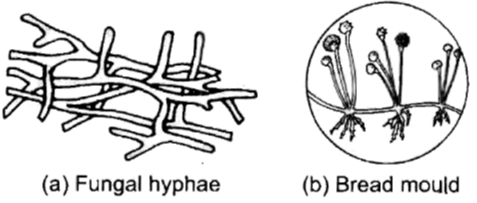
Fungi secretes digestive juices on dead and decaying matter and convert it into a solution. Then they absorb nutrients from it in soluble forms. Fungal spores are present in the air and they germinate & grow on wet and warm things and spoil the things.
Some fungi are useful for various purposes like
In food - Mushrooms (Agaricus)
In Bakery - Yeast (Saccharomyces)
In Medicines - Penicillium notatum from which Ist antibiotic penicillin has been obtained.
Fungi causes diseases in plants like rust (puccinia), smut (ustilago), in wheat and ring worm in animals. Caesar mushroom or poison cup looks like mushroom but it is lethal.
(C) Symbiotic Plants
Mutual relationship between two organisms in which both organisms are benefitted and they share shelter and Nutrients is called Symbiosis. These organisms are called Symbionts. Certain fungi live in the roots of trees (Mycorrhizae). The plant provides Nutrients to the fungi and fungi help the plant to take up water and nutrients from the soil.
Lichens are symbiotic association between algae and fungi. in which fungi provides shelter, water and minerals to the algae and algae provide food to fungi by photosynthesis. Lichens are termed as pollution indicator as they cannot survive in air polluted SO2 condition.
Leguminous plants like gram, moong, urad, peas and beans have nodules in which Rhizobium bacteria is found. This Rhizobium convert atmospheric nitrogen into nitrates for leguminous plant.
(D) Insectivorous plants 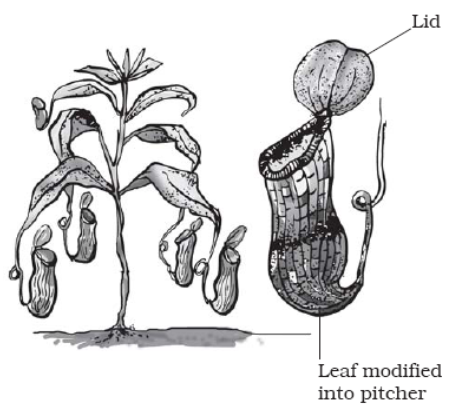
Some plants can trap insects and digest them to obtain nitrogen are called Insectivorous plants. These plants are green but found in nitrogen deficient soil. So these plant trap insects and feed on to fulfill their nitrogen requirement. These plants are known as partial autotrophs. e.g. Pitcher plant (Nepenthes), Venus flytrap, Sundew, Bladderwort
In pitcher plant leaf is modified into pitcher. Leaf apex forms a lid which helps in opening and closing of pitcher. Inside pitcher downwardly directed hairs are present. Which does not let an insect to come out.
When insects sit on opening of pitcher, it slips down and is trapped by hairs than lid gets closed and insect is digested by digestive juice secreted by pitcher.
Other Modes of Nutrition in Plants
Other modes of Nutrition in plants
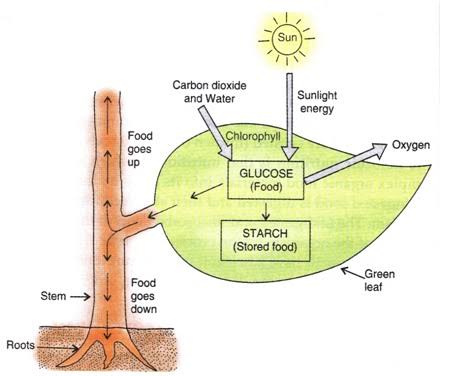
Autotrophic – Plants exhibit autotrophic nutrition and are called primary producers. Plants synthesis their food by using light, carbon dioxide and water.
Heterotrophic – Both animals and human beings are called heterotrophs, as they depend on plants for their food.
Saprotrophs
Saprotrophs
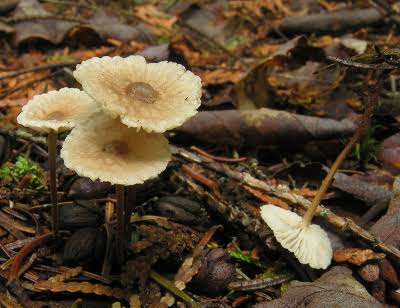
Saprotroph, also called saprophyte or saprobe, organism that feeds on non-living organic matter known as detritus at a microscopic level .Saprotrophic organisms are considered critical to decomposition and nutrient cycling and include fungi, certain bacteria, and fungus like organisms known as water (phylum ).Saprotrophs feed by a process known as absorptive nutrition, in which the nutritional substrate (e.g., dead organism or other non-living organic matter) is directly digested by a variety of enzymes that are excreted by the saprotroph. The enzymes convert the detritus into simpler molecules, which are then absorbed by the cells to feed the organism.
How Nutrients are Replenished in The Soil.
How nutrients are replenished in plants
Nutrients can be replenished in the following ways: Fertilisers and manures contain plant nutrients such as nitrogen, phosphorous and potassium, etc. So, when fertilisers and manures are added to the soil in the fields, then the soil gets enriched with nutrients like nitrogen, phosphorous and potassium, etc.
Nutrition in animals
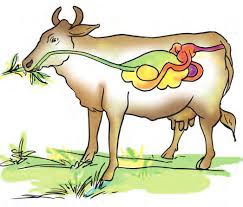
Nutrition in animals depends upon the feeding habits of the animals. The process of taking in food is called ingestion. The method of ingestion is different in different animals. For example-Bees and hummingbirds suck nectar from plants, python swallows its prey and cattle feed on grass.
Different feeding habits of animals are the result of evolution. Among the terrestrial animals, the earliest forms were large amphibians that ate fish. While amphibians like frogs fed on small fish and insects, the reptiles began feeding on other animals and plants.
The specialization of organisms towards specific food sources and of course specific ways of eating is one of the major causes of the evolution form and function. For example, the differences in the parts of mouth and shape of the teeth in whales, mosquitos, tigers and sharks or distinct forms of beaks in birds, such as in hawks, woodpeckers, pelicans, hummingbirds, and parrots are the results of adaptation to different types of eating by these animals.

 SOLUTIONistic HALT
SOLUTIONistic HALT
 Grow Career Publication
Grow Career Publication
